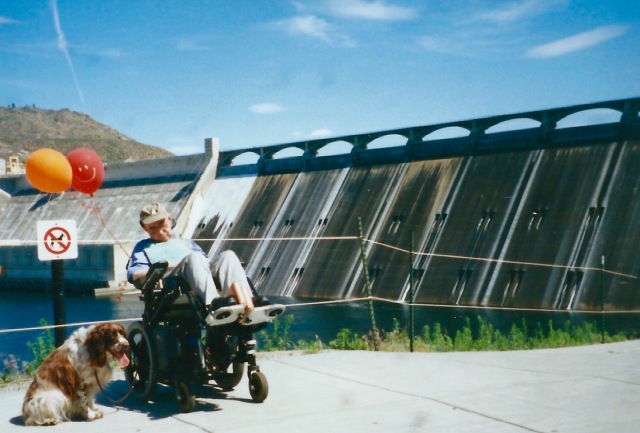
If my late husband could’ve written his memoir, the title might have been “From Millionaire to Medicaid in One Not-so-easy Stroke.” Some twenty percent of U.S. citizens access health care through Medicaid, the government program for the elderly, disabled and poor. John certainly never expected to be one of them. He was a successful, small-town newspaper publisher when he was paralyzed by a brain stem stroke at age 61. Diagnosed with “Locked-In Syndrome,” John’s fully functioning brain was locked inside a body that could not move, speak or eat.
He required skilled and vigilant care 24/7. He was fed through a stomach tube. A tracheotomy tube protected his airways. He communicated by blinking his eyes, using a simple alphabet code. We were determined that he would live at home, not in a facility. We had good insurance, but insurance doesn’t cover everything and eventually benefits run out.
We sold our newspaper—the beloved business that had brought us together and been our shared life—for a million dollars and change. I spent it all. I spent it on paid caregivers, reducing my caregiving load to only 80 or 90 hours a week. I spent it on assistive devices—everything from a talking computer to a specially designed shower chair. I spent it on physical, occupational and speech therapy. Daily therapy motivated John to live.
There’s a medical myth that stroke survivors “plateau” or stop recovering anywhere from six months to two years after the event. Seven years after his stroke, John was finally able to steer his electric wheelchair, leading a parade of friends and family across the mile-long spillway of Grand Coulee Dam. It was a publicity stunt to dramatize the importance of long-term therapy for stroke survivors. John’s determination drew national media attention.
Ultimately our money ran out. It’s been well established that medical bills are the chief reason for family bankruptcy in the United States. I knew of broken-hearted spouses who were forced into so-called “Medicaid divorces,” the only way they could get care for their loved ones. We escaped both bankruptcy and divorce with the help of an adept attorney. When I expressed embarrassment to a social worker about receiving state aid, she contrasted what we were receiving to what it would cost to put John in a nursing home, where nearly two-thirds of Medicaid patients live.
“The state’s getting a bargain,” she said.
Nearly fourteen years after his stroke, John died of respiratory failure. He did not leave a wealthy widow, but those fourteen years were the richest time of my life.
Because of today’s political climate, Medicaid cutbacks are apparently inevitable. Under proposed legislation, they won’t be immediate. It’s more like the proverbial frog who sits calmly in warm water on the stove. When the water ultimately gets too hot, it’ll be too late. We’re all going to feel it in when we reduce what is already minimal care for our poor, disabled and elderly.


God bless you Mary. May John rest in God’s eternal love! You embodied that love in your care and words for and about John. Thank you!
LikeLike
Reblogged this on wrestlingwiththelord and commented:
A friend from Holden posted this. Food for thought for our country.
LikeLike
Thank you Mary for this and everything!
LikeLike
Under the ‘medicaid’ story, is the love story… thank you for sharing it with us.
LikeLike
John Andrist was a good man who contributed to society in positive ways. It is sad what happened to his mind because one can only wonder how much more he might have contributed had he remained in good health for his entire life. But I suppose one can look at his journey and take away the importance of expressing gratitude for each moment we remain healthy on our own journey. What is important is not how long we live, but how we live while we are here.
LikeLike
Thank you for these honest, powerful, and chilling words that resonate with those of us who have the illusion that we are invulnerable.
LikeLike
Pingback: A Tale of A Stroke: Two People’s Love, Courage and Community– from Millionaire to Medicaid | The O'Connor Report